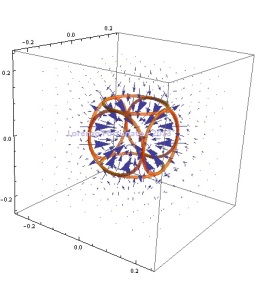I have been reading about the idea of ‘mini-atoms’ as a possible explanation for LENR and frankly this is so ridiculous that is almost offensive. It is like throwing away all the well-known concepts of quantum mechanics.
The hydrogen atom is regulated by quantum mechanics. In particular the non-relativistic Schroedinger equation with the pure Coulomb force between the proton and the electron explains very well all the properties and all of the energy spectrum of the hydrogen atom.
Now, these people that are patenting LENR devices (only to sell the patent to stupid enterpreneurs or to shift capitals to Panama?) want us to believe that mini-atoms are formed and that they convert into virtual neutrons and this convert nickel into copper.
Come on boys are you drunk?
1- the concept of mini-atom is unacceptable for the following reason. The 1s electron of hydrogen has a very well-known probability of sitting anywhere in space. Its wavefunction, R(r)=(2/a0^3/2) e^(-r/a0) has a little non-zero tail extending down to zero, which means there is a tiny probability of the electron to be found within the volume of the proton. This probability (calculated by integrating the wavefunction on the volume of the nucleus/proton) is ~5*10^(-15), tiny, but not zero (red around zero in the picture, not to scale). This DOES NOT MEAN that a mini-atom is formed. The system is always the same: an atom with the usual size (about 1 Angstrom) and only for a very short period the electron goes close to the nucleus and then turns back to the standard size. For that matter, the hydrogen atom has an even higher probability, ~3*10^(-14), to be greater than 10 Angstroms! (red on the right in the picture, not to scale). Nobody ever speaks of maxi-atoms!
tail extending down to zero, which means there is a tiny probability of the electron to be found within the volume of the proton. This probability (calculated by integrating the wavefunction on the volume of the nucleus/proton) is ~5*10^(-15), tiny, but not zero (red around zero in the picture, not to scale). This DOES NOT MEAN that a mini-atom is formed. The system is always the same: an atom with the usual size (about 1 Angstrom) and only for a very short period the electron goes close to the nucleus and then turns back to the standard size. For that matter, the hydrogen atom has an even higher probability, ~3*10^(-14), to be greater than 10 Angstroms! (red on the right in the picture, not to scale). Nobody ever speaks of maxi-atoms!
These ignorant or malicious people cite the Heisenberg principle and the DeBroglie wavelength (easy concepts that most people can become familiar with), but either ignore or hide the Schroedinger equation and forget that we can make calculations and predictions with it.
2- You might say that, do the right math or not, the electron ‘enters’ of ‘feels’ the proton from very close, therefore a conversion into a neutron might happen, after all this is the mechanism that we think explains the beta-plus decays! NO, THAT IS NOT TRUE FOR THE SINGLE PROTON FOR ENERGY REASONS: even if you put the electron (that is moving at tiny atomic energies measured in eV) on top of the proton, it does not have enough energy to convert the proton into a neutron because the neutron is a heavier particle and the process DOES NOT start spontaneously.
Different is the case if you shoot very energetic electrons (with energy measured in Mega-eV) on protons, you might observe beta-decay into a neutron and neutrino. Mass of proton ~938.3 MeV, mass of electron ~0.5 MeV, mass of neutron ~939.6 MeV, therefore
mass proton+electron ~ 938.8 you still miss 0.8 MeV. The energies of an orbital electron are of the order of 0.000013 MeV, we can safely neglet them. Where the fuck is the missing energy to allow the conversion?
Once again these people are either uniformed or just evil. Once again they mix perfectly valid concepts with bullshit and induce people to believe them…
3- Then we are told the following “but you unmovable conventional skeptical scientists are just firm in your opinions, you are not open-minded!”. THAT IS NOT TRUE. Scientists evaluate and ponder, but cannot forget what is already WELL-KNOWN, PROOVED and ESTABLISHED. There are several experiments that have been conceived, planned, funded, constructed, tested and completed in order, for example, to establish the half-life of the proton and test if, maybe, this proton conversion exists anyway! The result is that the proton is stable and the lower limit of this stability is at least 10^33 years, that is much much more than the known age of the universe (slightly more than 10^10 years). The proton is terribly stable.
Once again, the people saying so are either unschooled or just nasty. Study first, think second and maybe speak at last.
4- Just to finish: why the mini-hydrogen-atom should act only on nickel ? If this never-seen-before (and believe me, never-to-be-seen-later) virtual neutrons allow the proton to overcome the coulomb barrier without problems and make a fusion reaction, why they don’t do it in ordinary molecules, in crystals, in melting metals in a furnace? Why nickel should be better than calcium, iron or palladium?
Simple answer: they just don’t exist at all.




